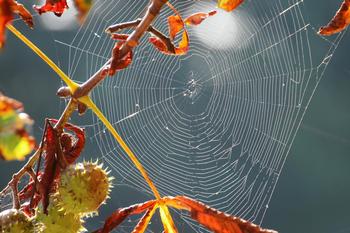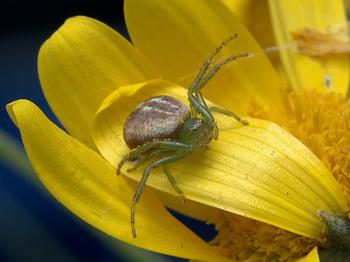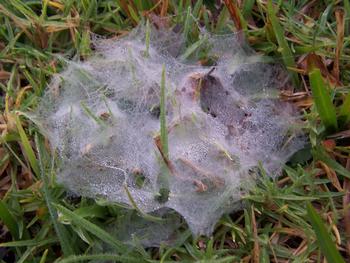What are spiders doing in my garden?
-
Marty Nelson
-
If Miss Muffet in the children’s nursery rhyme had known more about garden spiders, she might not have been so frightened. Spiders are beneficial garden inhabitants who are much more interested in feeding on insects rather than bothering humans. You might think of them as an eight-legged pest control service operating in your garden.
 Webs on garden plants are signs of spiders at work trapping insect pests. Photo: Pixnio
Webs on garden plants are signs of spiders at work trapping insect pests. Photo: PixnioSpiders are not insects; they are arthropods belonging to the order Araneae in the class Arachnida. In addition to the number of legs, they differ from insects in that they have only two body parts and they lack wings and antennae. They also have six to eight eyes, often arranged in two rows. Although most spiders do produce venom and have jaws ending in fangs, few can bite through human skin. The only exceptions common in California are the widow spiders which spend most of their time hiding and rarely attack humans unless provoked. Spiders basically just want to be left alone to catch insects.
Spiders capture their prey in three ways. The largest group constructs webs using their specialized organs called spinnerets to produce the fine silk threads they weave into traps for their prey. Web arrangements differ among spider families. Some, like those of the orb weavers or garden spiders, are elaborate and symmetrical, spun in concentric circles. Theirs is the classic spider web pattern that can be amazing in its artistry. Funnel weavers, such as the grass spiders, create webs with a tunnel entrance in the center. The spider waits in the tunnel and captures insects that disturb the web. Cobweb spiders spin messy, sticky webs, often in dark corners or hidden spaces. Most of these spiders are harmless. However, the western black widow also belongs to this family.
The second most common capture method is employed by the hunting spiders, who are more mobile and aggressively track down their quarry instead of waiting for it to come to them. Wolf spiders and jumping spiders are active hunters. Wolf spiders are the larger brown spiders often found in vegetation or running along the ground. Jumping spiders are usually more colorful and can be identified by their jerky movements. They are nimble acrobats who can jump many times their body length. Hunting spiders use their silk-spinning abilities to shelter themselves and their eggs. Crab spiders often wait in flowers to ambush their prey, Photo: flickr
Crab spiders often wait in flowers to ambush their prey, Photo: flickrThe third group are the ambush hunters who wait motionless ready to pounce on any unsuspecting insect coming within easy grasp. You might think of them as lazy hunters because they need to hang out where insects are numerous. Crab spiders, the small spiders with enlarged front legs, are ambush hunters who sit on leaves or hide in flower petals, waiting for their victims.
The Zoropsis spider (Zoropsis spinimana), is a large spider from the Mediterranean that has recently established itself in the Bay Area. It is a lot like the wolf spider in appearance and habits. So far, it has been found around and in human dwellings, but it may be venturing out into gardens as well. It is harmless, even though it may look scary.
If spiders are a concern, the best approach is to remove hiding spots by clearing clutter and debris and hosing or brushing off unwanted webs. Individual spiders that wander indoors can be humanely caught and released outdoors. Remember, spiders are shy, solitary, and not interested in harming you or your plants. Pesticides do not provide any long-term control, harm beneficial insects in addition to spiders, and should be avoided. Grass spiders spin funnel-shaped webs and wait for insects to walk or fly into them. Photo: Pixnio
Grass spiders spin funnel-shaped webs and wait for insects to walk or fly into them. Photo: PixnioThe next time you are in the garden, look around and see how many kinds of spiders you can find. Learn to recognize them and appreciate the work they are doing to rid your garden of pests. More information and help in identifying common spiders can be found at https://ipm.ucanr.edu/.



